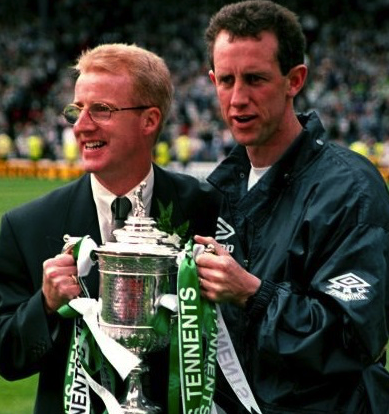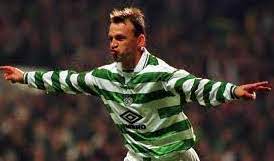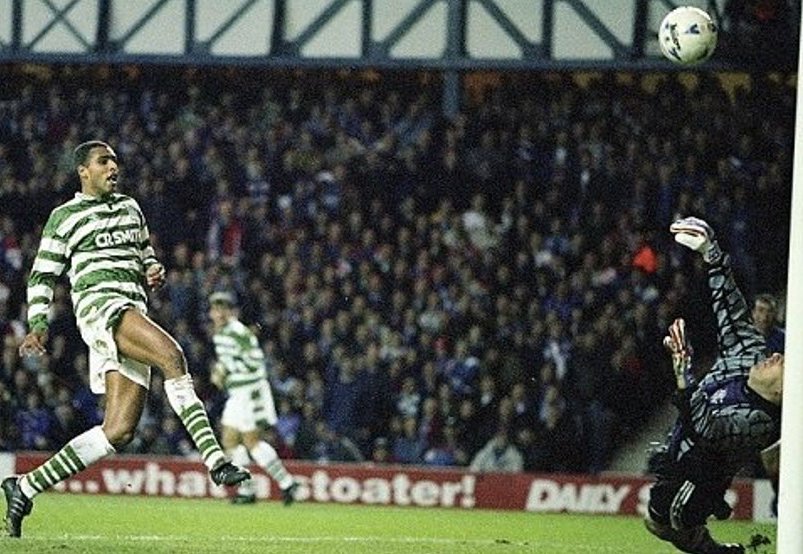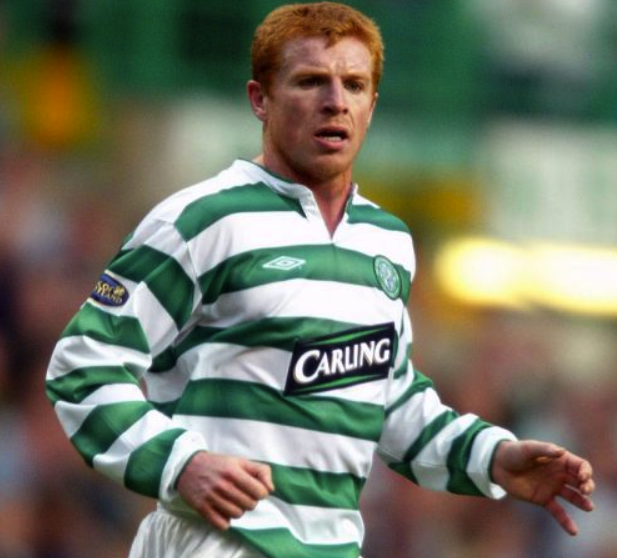TOMMY BURNS celebrated his return to Celtic as manager on July 12 1994 by winning the Scottish Cup with the club’s 1-0 win over Airdrie the following year.
The league title, though, was the iconic Celt’s main target as he prepared for his second term in charge of the team that was always closest to his heart.
In another CQN EXCLUSIVE series, we chart Tommy Burns’ career as the Hoops gaffer during turbulent times on and off the field. Here is the seventh instalment from Alex Gordon’s tribute book, ‘The Winds of Change’, which was published by CQN in 2015.
Please enjoy.

TOMMY BURNS emulated the legendary Jock Stein in season 1995/96 – and still won NOTHING for his exceptional efforts.
Extraordinarily, Burns, in his second campaign in charge of Celtic, suffered one solitary league loss in 36 examinations just as Big Jock had managed in 1967/68 during a 34-game league campaign.
There was one major difference, though. Burns saw his team finish four points adrift of Rangers while Stein picked up his third successive crown, two points ahead of the Ibrox outfit.
In total, Burns conceded defeat in only three domestic games in three different competitions to the same opponents and that was enough to wreck a complete season. A rare header from Ally McCoist ended Celtic’s interest in the League Cup at the quarter-final stage at Parkhead on September 19 1995 and Walter Smith’s team returned 11 days later to administer another setback, this time 2-0 in the league.
The Ibrox side edged the Scottish Cup semi-final encounter at Hampden in April by 2-1 to complete a horrendous hat-trick for the Parkhead side.

SILVERWARE CELTS…Tommy Burns and assistant boss Bily Stark parade the Scottish Cup after the 1-0 Final win over Airdrie at the end of their first season in 1994/95.
Burns had transformed Celtic from the previous season, earned accolades for the way he had got the team playing, all neat passing and fluent movement, rapturous applause avalanched in his direction for bringing colour back to the grey east end of Glasgow, but the trophy cabinet wasn’t exactly groaning under the weight of silverware.
And, in a results-driven business, that was all that mattered to the Celtic manager.
Burns realised there had to be a dramatic improvement within the playing ranks. Brian McLaughlin, Brian O’Neil and Simon Donnelly had settled into the first-team squad, but other fringe players such as Stuart Gray and Chris Hay weren’t quite ready for the step up on a permanent basis.
Old favourite Charlie Nicholas had been freed to play out the remainder of his career with Clyde while Tony Mowbray moved to Ipswich Town in a £300,000 deal. As the Celtic boss had promised in the aftermath of the Hampden success over Airdrie, players had been identified and he was anxious to get business done in the close season.
The previous term he had brought in Pierre van Hooijdonk, Phil O’Donnell, Andy Walker and Tosh McKinlay for a total outlay of £3.9million which was a reasonable sum of money. Contrast that, though, with Walter Smith’s financial muscle across the Clyde. He was allowed to splash almost £6million in welcoming Brian Laudrup (Fiorentina), Basile Boli (Marseille), Alex Cleland and Garry Bollan (both Dundee United) and Billy Thomson (Motherwell). He also swapped Dave McPherson for Hearts’ Scottish international centre-half Alan McLaren.

PARADISE…Motherwell midfielder Phil O’Donnell was one of Tommy Burns’ first signings for Celtic after his July 12 1994 arrival.
As Burns plotted for the new campaign, he admitted: “I was only too aware of Rangers sources being quoted almost on a daily basis that they were now going for eight successive titles, then nine would be the target to equal Celtic and then into double figures.
“We couldn’t stand back and let that happen. I knew the players I wanted, the quality of the individual who would wear the green and white hoops. We had all worked hard throughout the summer because we knew we had to turn the corner once and for all.”
Andreas Thom was the surprise close season signing when he arrived from Bayer Leverkusen on August 4. The former East German international attacking midfielder was once rated as one of the very best by none other than the iconic Franz Beckenbauer, who conceded Thom might have been worthy of a place in West Germany’s World Cup-winning team of 1974.
Fanciful figures were bandied about concerning the exact amount of the transfer fee with many insisting it was £4million, just £300,000 short of the reported figure paid by Rangers for Paul Gascoigne from Lazio the previous month. The truth is it was almost half Gascoigne’s valuation with the deal being concluded and the Bundesliga outfit picking up £2.2million.

HOOP HOOP HOORAY…Andreas Thom celebrates one of his early goals for Celtic.
There was no way Fergus McCann would sanction a £4million move for a player who would be 30 on his next birthday with little or no sell-on value.
Three days after the razzmatazz of Thom’s arrival, there was barely a ripple when John Hughes, a rugged, no-nonsense centre-half, arrived from Falkirk in exchange for £350,000. Burns had identified central defence as a problem area, as it had been for predecessors Liam Brady and Lou Macari.
Over the course of the first half of the season, versatile Jackie McNamara, son of the former Celtic favourite of the same name, joined in October in a £600,000 shift from Dunfermline and Danish midfielder Morten Wieghorst would cost an identical fee from Dundee in December.
Portuguese attacker Jorge Cadete turned up in March the following year in a convoluted and protracted transfer after falling out with his club, Sporting Lisbon.

DENIED…Pierre van Hooijdonk watches Rangers keeper Andy Goram make a super save in the thrilling 3-3 draw at Ibrox in 1995.
So, during the entire programme, Burns had spent exactly £4.15million. That, too, was dwarfed with what was happening over at Ibrox. Including the temperamentally-fragile Gascoigne, Smith had taken his spending to a whopping £11.65million by introducing Russian striker Oleg Salenko at £2.5million from Valencia, Danish frontman Erik Bo Andersen (£1.5million, Aalborg), right-back Stephen Wright (£1.5million, Aberdeen), central defender Gordan Petric (£1.5million, Dundee United) and midfielder Derek McInnes (£350,000, Morton).
It was hardly a level financial playing field.
David Ginola, the maverick French winger, was within minutes of joining the Hoops revolution and was actually discussing terms with Burns and the money men when Newcastle manager Kevin Keegan placed a phone call to Celtic Park. He was making an eleventh-minute move for the Paris Saint Germain star with the matinee looks.
Incredibly, the phone was handed to Ginola and Celtic’s bid was dead in the water when he picked up the receiver and heard what Keegan had to offer. It doesn’t always pay to have good manners.

WAIT FOR IT…Celtic missed out on Neil Lennon at Crewe in 1995.
Davie Hay also makes an astonishing revelation about the identity of another player he was asked to scout. “A schoolteacher in England, a bloke called John Murphy, was a Celtic fan and got in touch to say we could do worse than have a look at a young midfielder in the lower league levels.
“I travelled down and that was the first time I ever saw Neil Lennon play. He was with Crewe at the time. I liked the look of him, but, at the time, Tommy needed players who could go straight into the first team and we had Paul McStay and John Collins in there.
“So, I noted the name, but Martin O’Neill signed him for Leicester City in 1996 and the Celtic fans had to wait another four years before they saw him in the green and white hoops.”
*TOMORROW: Don’t miss the eighth EXCLUSIVE instalment of The Tommy Burns Story – only in your champion CQN.

